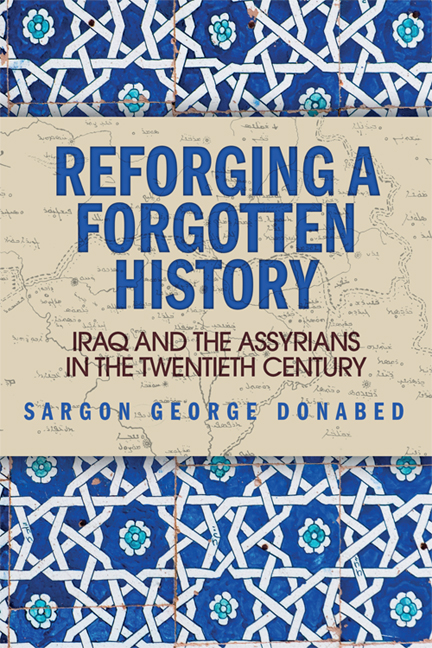Book contents
- Frontmatter
- Contents
- List of Figures
- List of Tables
- Abbreviations
- Acknowledgements
- Dedication
- Map
- Introduction
- 1 Integrating the Assyrian Question
- 2 Framing the Assyrian Narrative: Late Nineteenth and Early Twentieth Century
- 3 Iraq: Building a ‘Nation’-State
- 4 The Birth of the Republic and an Autonomist Struggle
- 5 Enduring Discord: Political Machinations and Border Clearings
- 6 New Movements and War on the Horizon
- 7 State Formation, State-building and Contentious Pluralism
- 8 Conclusion
- Glossary
- Appendix A Village Data
- Appendix B Documents Concerning Cultural and Political Organisations
- Bibliography
- Index
6 - New Movements and War on the Horizon
Published online by Cambridge University Press: 05 September 2016
- Frontmatter
- Contents
- List of Figures
- List of Tables
- Abbreviations
- Acknowledgements
- Dedication
- Map
- Introduction
- 1 Integrating the Assyrian Question
- 2 Framing the Assyrian Narrative: Late Nineteenth and Early Twentieth Century
- 3 Iraq: Building a ‘Nation’-State
- 4 The Birth of the Republic and an Autonomist Struggle
- 5 Enduring Discord: Political Machinations and Border Clearings
- 6 New Movements and War on the Horizon
- 7 State Formation, State-building and Contentious Pluralism
- 8 Conclusion
- Glossary
- Appendix A Village Data
- Appendix B Documents Concerning Cultural and Political Organisations
- Bibliography
- Index
Summary
It is the constant fault and inseparable quality of ambition that it never looks behind it.
SenecaThe Iran–Iraq War
With the accomplishments and setbacks of the late 1970s in hindsight, the turn of the decade signalled yet another difficult situation for Iraq and her Assyrian inhabitants. Following the Islamic revolution in Iran in 1979 and further instability in the northern region, the Kurdistan Democratic Party (KDP) revived its alliance with Tehran. On 22 September 1980, Iraq, under a fearful and power-motivated Saddam Hussein, went to war with Iran. In an attempt to eliminate future threats and possible rebel elements, the military drafted many Assyrian men and deployed them to the front lines. Many disappeared or were killed. Most of the combatants had little desire to fight in a war for an oppressive regime, yet the war effort ‘involved the conscription of large numbers of Assyrian soldiers, as some forty thousand of these unwilling recruits were killed, wounded, imprisoned in Iran, or missing in action’. At least 266 Assyrians were held as prisoners of war in Iran, some for more than twenty years. Overall, 200,000–300,000 people, predominantly Shia Arabs from the southern regions of Iraq, were deported to Iran in 1980.
It is not inconceivable that the positioning of Christians on the front lines and in difficult military situations during the Iran–Iraq War was done with malevolent purpose by the regime. Most Assyrians who survived spoke of threats against their person from their fellow Muslim combatants. In essence, it would not do for a Christian to kill a Muslim – an enemy Iranian or otherwise. As Christians, Assyrians feared a religiously motivated backlash from Iraqi soldiers for killing fellow Muslims. The Assyrians of Iranian origin in Iraq included refugees from Urmia during the Baqubah refugee camp crisis (see Chapter 2) who had lived in Iraq since the end of the First World War, as well as those recent refugees following the 1978–9 Islamic revolution in Iran and ousting of Muhammad Reza Shah Pahlavi. In the latter case, most families were visited briefly by an army officer, told to retain only the clothes on their person, packed into buses, and then driven to the border of Iran and forced into exile in a inhospitable region.
- Type
- Chapter
- Information
- Reforging a Forgotten HistoryIraq and the Assyrians in the Twentieth Century, pp. 191 - 220Publisher: Edinburgh University PressPrint publication year: 2015



